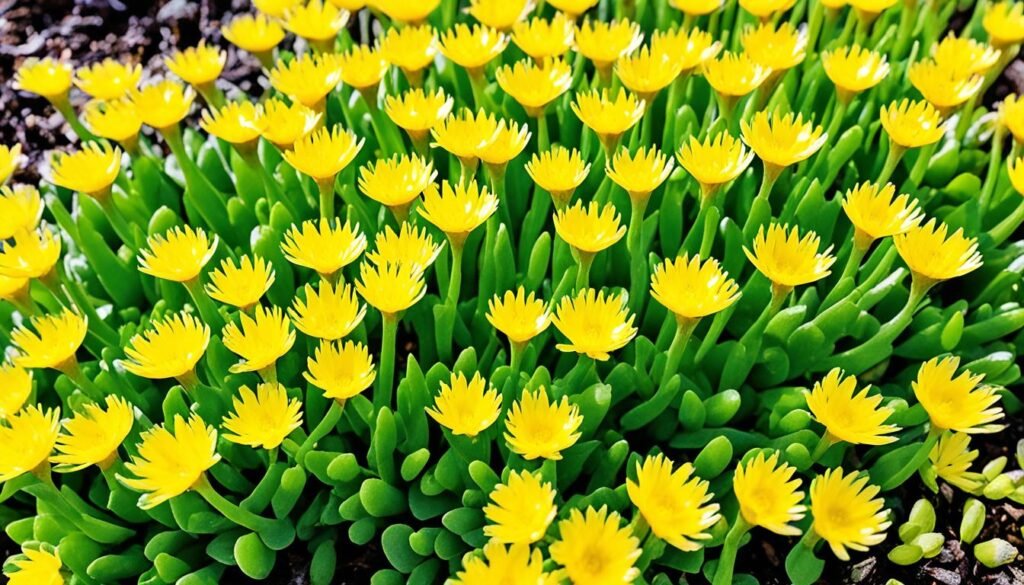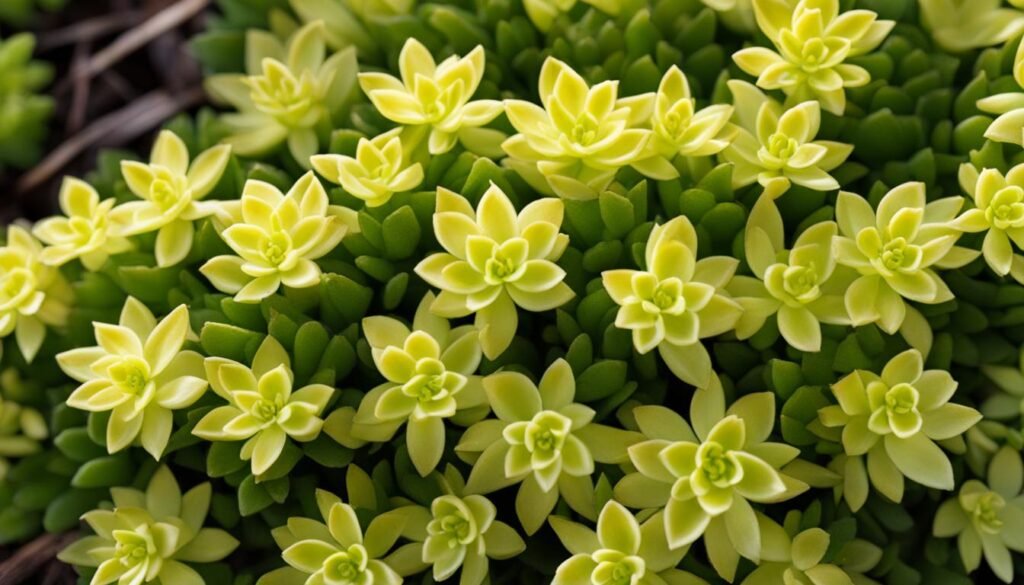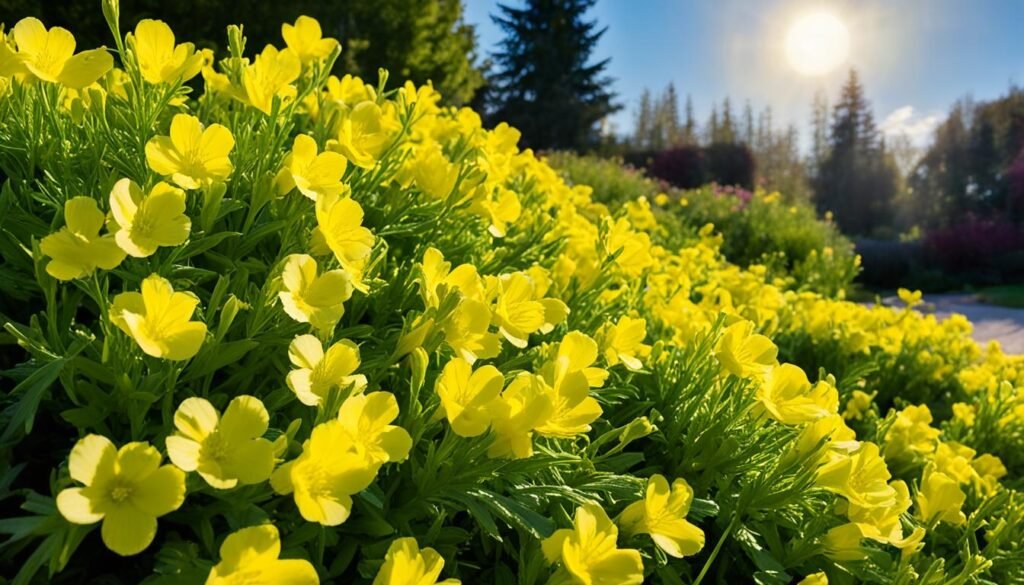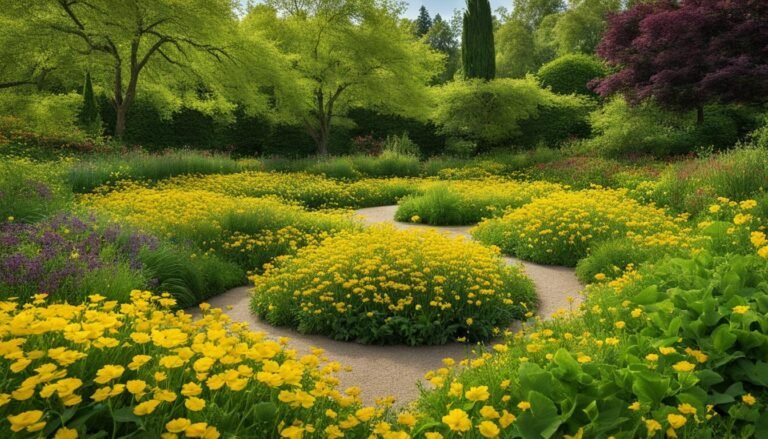Imagine strolling through a garden bathed in vibrant yellow hues, the delicate petals of yellow flowers swaying gently in the breeze. The sight is both mesmerizing and uplifting, creating a joyful ambiance that captivates your senses. This is the power of yellow flowering ground covers, which have the ability to transform any outdoor space into a sunlit haven.
Whether you have a sunny garden, a shaded spot, or a sloping landscape, there is a yellow ground cover that can thrive in your unique environment. These ground cover plants not only provide stunning visual appeal but also offer practical benefits such as low maintenance, resilience to drought, and shade tolerance.
Curious to discover the top yellow flowering ground covers for your garden? Let me be your guide as we explore a world of vibrant blooms and uncover tips for incorporating these beauties into your landscaping.
Key Takeaways:
- Yellow flowering ground covers can add a splash of sunshine to your garden.
- There are options for low maintenance, shade tolerance, and drought tolerance.
- Consider the specific needs of your garden, such as sun exposure and soil type.
- Popular yellow flowering ground covers include yellow alyssum, hardy yellow ice plant, barren strawberry, spring cinquefoil, yellow stonecrop, evening primrose, yellow archangel, woolly yarrow, wild ginger, and creeping Jenny.
- By choosing the right yellow flowering ground cover, you can create vibrant and beautiful landscapes that will brighten your garden for years to come.
Yellow Alyssum (Aurinia saxatilis)
Yellow alyssum, also known as Aurinia saxatilis or basket-of-gold, is a bright and cheerful ground cover that can thrive in a variety of conditions. It requires very little maintenance and can handle extreme heat, dry conditions, full sun, and dappled shade. Yellow alyssum blooms from April to May with small, lemon-yellow flowers. It is a herbaceous perennial that grows 2 to 6 inches tall and is suitable for borders, beds, rockeries, and containers. It prefers sandy, well-drained soil and is low maintenance, requiring occasional trimming and watering to avoid soggy soil.
One of the advantages of yellow alyssum is its versatility. It can withstand full sun as well as dappled shade, making it a great choice for different areas of your garden. Whether you have a sunny spot or a partially shaded area, yellow alyssum can brighten up the space with its vibrant blooms.
Yellow alyssum is a hardy plant that can adapt to various soil types. However, it thrives best in sandy, well-drained soil. This makes it suitable for gardens with different soil conditions, from sandy to loamy. It is also drought-tolerant, making it an ideal choice for low-maintenance landscapes.
Propagation and Maintenance
Yellow alyssum can be propagated through seed or division. If you choose to propagate through seeds, sow them directly in the ground during spring or fall. For division, you can separate the plants in early spring or fall.
In terms of maintenance, yellow alyssum is a low-maintenance ground cover. It requires occasional trimming to maintain its shape and remove any dead or wilted flowers. Watering is only necessary when the soil is dry, as yellow alyssum is adapted to survive in dry conditions.
USDA Hardiness Zones and Bloom Time
Yellow alyssum is suitable for USDA hardiness zones 3-9. It blooms from April to May, providing a burst of color in early spring. Its vibrant yellow flowers create a stunning contrast against the green foliage, enhancing the beauty of your garden.
Applications and Soil Type
Yellow alyssum can be used in various applications in your garden. Whether you want to create borders, fill in beds, or add a pop of color to rockeries and containers, yellow alyssum is a versatile choice. Its compact growth habit and vibrant blooms make it an eye-catching addition to any landscape.
When it comes to soil type, yellow alyssum prefers sandy, well-drained soil. It can also tolerate other soil types, such as loamy or gravelly soil. However, it is important to ensure that the soil is well-drained to prevent waterlogging, as yellow alyssum is susceptible to root rot in poorly drained soil.
Summary
Yellow alyssum, or Aurinia saxatilis, is a stunning ground cover plant that adds a bright and cheerful touch to your garden. With its ability to thrive in different conditions and low maintenance requirements, it is an excellent choice for creating vibrant landscapes. Whether under full sun or dappled shade, yellow alyssum will bloom beautifully and bring joy to your outdoor space.
Hardy Yellow Ice Plant (Delosperma nubigenum)
I am excited to introduce the hardy yellow ice plant, also known as Delosperma nubigenum. This stunning ground cover plant is a low-maintenance succulent that will bring vibrant color to your garden. With its cheerful daisy-like blooms, the hardy yellow ice plant is sure to catch the eye.
One of the standout features of this ground cover is its ability to thrive in dry conditions. It is highly drought-tolerant and can withstand long periods without water. So if you live in an area with low rainfall or if you simply want to conserve water, this plant is an excellent choice.
The hardy yellow ice plant is also perfect for sun-drenched gardens. It loves full sun exposure and will flourish in bright, sunny areas of your yard. You can plant it in spots that receive direct sunlight throughout the day, and it will reward you with its vibrant yellow flowers.

When it comes to maintenance, this ground cover requires minimal attention. It is a perennial plant, meaning it will come back year after year without the need for replanting. It has a compact growth habit, reaching a height of up to 3 inches and spreading up to 18 inches wide.
The hardy yellow ice plant blooms fully from late spring to early summer, filling your garden with bursts of yellow. Even during dry spells, this resilient plant recovers quickly and continues to provide a beautiful display. It is a great addition to rock gardens, border fronts, and container gardens.
For optimal growth, the hardy yellow ice plant prefers well-drained soil, such as sandy or gravelly soil. It is important to ensure that water does not accumulate, as this can lead to rotting. Occasional trimming and removal of dead flowers will help maintain the plant’s appearance.
Key Features of the Hardy Yellow Ice Plant:
- Low-maintenance succulent
- Vibrant yellow daisy-like blooms
- Drought-tolerant and thrives in full sun
- Perennial with compact growth habit
- Blooms fully from late spring to early summer
- Spread up to 18 inches wide
- Suitable for rock gardens, border fronts, and containers
- Requires well-drained, sandy or gravelly soils
The hardy yellow ice plant is a beautiful and resilient ground cover that will add a pop of color to your garden. With its low maintenance needs and ability to withstand dry conditions, it is a perfect choice for busy gardeners and those living in arid regions. So consider incorporating the hardy yellow ice plant into your landscape and enjoy its cheerful blooms year after year.
| Attribute | Details |
|---|---|
| Plant Name | Hardy Yellow Ice Plant |
| Scientific Name | Delosperma nubigenum |
| Plant Type | Ground cover |
| Hardiness Zones | 4 to 9 |
| Exposure | Full sun |
| Soil Type | Well-drained, sandy or gravelly soils |
| Mature Size | Up to 3 inches tall, spreads up to 18 inches wide |
| Bloom Time | Late spring to early summer |
| Propagation | Divisions, cuttings, seeds |
| Application | Rock gardens, border fronts, containers |
| Maintenance | Low maintenance; occasional trimming and dead flower removal |
Barren Strawberry (Waldsteinia fragarioides)
The barren strawberry, scientifically known as Waldsteinia fragarioides, is a versatile ground cover plant that adds a vibrant touch to any garden. With its bright yellow flowers, this native North American perennial creates a stunning display from early spring to early summer.
Barren strawberry is a low-maintenance plant that thrives in a variety of conditions, making it suitable for different garden landscapes. It prefers medium, well-drained soils and can tolerate both full sun and part shade exposure.
This ground cover plant has a mature size of 3 to 6 inches tall, making it an excellent choice for borders, rock gardens, and woodland gardens. Its evergreen foliage adds interest all year round, even when it’s not in bloom.
| USDA Hardiness Zones | 3-9 |
|---|---|
| Propagation | Rhizomes, division, or seeds |
| Spread | 12-18 inches |
| Duration | Perennial |
| Sun Exposure | Full sun to part shade |
| Soil Type | Medium, well-drained |
| Application | Borders, rock gardens, woodland gardens |
| Maintenance | Low maintenance |
Barren strawberry is a reliable and beautiful ground cover plant that requires little maintenance and adds a pop of color to any garden.
Benefits of Barren Strawberry
- Provides bright yellow flowers for early spring to early summer
- Evergreen foliage adds interest even when not in bloom
- Tolerates a wide range of sun exposure, from full sun to part shade
- Can handle medium, well-drained soils
- Low-maintenance plant once established
Growing Barren Strawberry
- Choose a location with medium, well-drained soils.
- Plant barren strawberry in early spring or fall.
- Water regularly during the first growing season to establish the plant.
- Apply a layer of mulch to conserve moisture and suppress weeds.
- Trim any dead foliage or flowers as needed to maintain the overall appearance.
Spring Cinquefoil (Potentilla neumanniana)
Spring cinquefoil, also known as Potentilla neumanniana, is an evergreen perennial ground cover with yellow buttercup-like flowers. It blooms from late spring to early fall, adding a cool color combination of green and yellow to your garden. Spring cinquefoil has a low, mat-forming habit and is suitable for path edging, front borders of sunny areas, and rock gardens.
Spring cinquefoil is a great choice for gardeners looking for low maintenance ground cover plants. It can tolerate full sun but also part shade, making it versatile for different light conditions. This ground cover is hardy and can withstand a variety of conditions, making it suitable for USDA hardiness zones.
When it comes to propagation, spring cinquefoil can be easily grown from seeds or divided from established plants. It has a spreading habit and can quickly spread to fill in empty spaces. The duration of its bloom time is relatively long, from late spring to early fall, providing a steady splash of color throughout the growing season.
As for its mature size, spring cinquefoil grows to be around 6 inches tall, making it ideal for border edging or filling in gaps between other garden plants. It prefers full sun to thrive, but it can still perform well in part shade conditions.
In terms of soil type, spring cinquefoil prefers sandy, loamy, moist, and well-drained soil. However, it can adapt to different soil conditions as long as they are not overly wet or compacted.
Spring cinquefoil can be applied in various garden settings, including residential landscapes, public parks, or commercial gardens. Its vibrant yellow flowers can add a pop of color to any outdoor space, creating a visually appealing and inviting atmosphere.
When it comes to maintenance, spring cinquefoil is considered to be a low-maintenance plant. It requires minimal pruning or deadheading to promote healthy growth and continuous bloom. Watering should be done in moderation, ensuring the soil remains evenly moist but not waterlogged.
Overall, spring cinquefoil is an attractive and versatile ground cover plant that can thrive in different garden settings. Its vibrant yellow flowers and low maintenance requirements make it an excellent choice for gardeners looking to add a splash of color and interest to their outdoor spaces.

Yellow Stonecrop (Sedum nuttallianum)
Yellow stonecrop, scientifically known as Sedum nuttallianum, is a stunning succulent ground cover that can elevate the aesthetic of any garden. With its nodding clusters of vibrant yellow blooms, this plant creates an eye-catching display that is sure to draw attention. Yellow stonecrop is not only visually appealing but also requires minimal maintenance, making it an excellent choice for busy gardeners.
This ground cover thrives in areas that receive full sun or partial shade, making it versatile for various garden settings. It is capable of withstanding different environmental conditions and has a long blooming period, from March through August. Growing up to 4 inches tall, yellow stonecrop spreads easily, providing ample ground coverage.
When it comes to cultivation, yellow stonecrop is relatively easy to propagate. It can be grown from cuttings or by dividing established plants. This makes it a practical choice for those who want to expand their garden effortlessly. Additionally, yellow stonecrop is adaptable to a range of USDA hardiness zones, making it suitable for gardens across the United States.
In terms of soil preference, yellow stonecrop thrives best in well-draining sandy or loamy soil. Its ability to tolerate different soil conditions adds to its versatility and adaptability as a ground cover option. Whether used in rockeries, borders, or container gardens, yellow stonecrop enhances the overall visual appeal of the landscape.
As a low-maintenance plant, yellow stonecrop requires minimal care. It is drought-tolerant, so watering should only be done when necessary. Additionally, occasional trimming can help maintain its shape and promote healthy growth. With proper care, yellow stonecrop serves as a reliable and long-lasting ground cover option.
Benefits of Yellow Stonecrop:
- Eye-catching clusters of vibrant yellow blooms
- Low maintenance and durable
- Thrives in full sun or partial shade
- Easy to propagate and adaptable to various hardiness zones
- Provides ample ground coverage
Cultivation and Maintenance:
- Choose a well-draining sandy or loamy soil for optimal growth.
- Ensure the plant receives full sun or partial shade.
- Water sparingly, as yellow stonecrop is drought-tolerant.
- Occasionally trim to maintain shape and promote healthy growth.
| Common Name | Scientific Name | Mature Size | Sun Exposure | Soil Type | Hardiness Zones | Bloom Time |
|---|---|---|---|---|---|---|
| Yellow Stonecrop | Sedum nuttallianum | Up to 4 inches tall | Full sun to partial shade | Well-draining sandy or loamy soil | 3-9 | March to August |

Evening Primrose (Oenothera biennis)
Evening primrose, or Oenothera biennis, is a vibrant ground cover with yellow flowers that bloom from spring to summer. It is a hardy plant that can tolerate full sun and requires low maintenance. Evening primrose is suitable for a variety of garden applications and can attract pollinators. It is a great choice for those who enjoy gardening in the evening.

Evening primrose, scientifically known as Oenothera biennis, is a versatile ground cover option for your garden. With its vibrant yellow flowers that bloom from spring to summer, it adds a cheerful touch to any outdoor space. This low maintenance plant is perfect for busy gardeners who want a pop of color without the hassle.
Evening primrose thrives in full sun, making it an ideal choice for areas with direct sunlight exposure. Whether you’re looking to fill in gaps in your flower beds or create a colorful ground cover, evening primrose is up for the task.
USDA hardiness zones: Evening primrose is adaptable to a wide range of climates, and it can be grown in USDA hardiness zones 3 to 9.
Propagation: Evening primrose can be propagated through seeds or transplants. If you plan on growing it from seeds, sow them directly into the soil in early spring. Transplants can be planted in early summer after the last frost.
Bloom time: Evening primrose produces vibrant yellow flowers that bloom from spring to summer, creating a stunning display in your garden.
Soil type: This ground cover prefers well-draining soil. If the soil in your garden is heavy and clay-like, consider amending it with compost or sand to improve drainage.
Application: Evening primrose works well as a ground cover in flower beds, borders, or rock gardens. It can also be used as a container plant to brighten up your patio or deck.
Maintenance: Evening primrose is a low maintenance plant. Once established, it requires minimal care. Water it regularly, especially during dry spells, and prune any dead flowers or foliage to promote new growth.
Yellow Archangel (Lamiastrum galeobdolon)
Yellow archangel, scientifically known as Lamiastrum galeobdolon, is a shade-tolerant ground cover that requires low maintenance. This versatile plant can tolerate a range of conditions and is particularly well-suited for shady areas in your garden. The vibrant yellow flowers of the yellow archangel create a stunning backdrop, adding a pop of color to any landscape.
The yellow archangel spreads easily, making it an ideal choice for filling large areas. It can thrive in various soil types and is relatively resistant to pests and diseases. This low maintenance ground cover is a great option for busy gardeners who want to enjoy a beautiful garden without too much effort.
When it comes to sun exposure, the yellow archangel prefers partial shade, making it suitable for areas with dappled sunlight. It is important to note that this plant can become invasive if not managed properly. Regular monitoring and pruning can help control its spread and maintain a tidy appearance.
To propagate the yellow archangel, you can divide the plant or take stem cuttings. It is a fairly easy plant to propagate, making it a good choice for gardeners who want to expand their ground cover area. The yellow archangel plants can reach a mature size of about 12 to 18 inches in height and spread.
In terms of USDA hardiness zones, the yellow archangel can thrive in zones 4 to 9, making it adaptable to various climates. This ground cover plant is a beautiful addition to borders, woodland gardens, and shady areas that need a burst of vibrant color.

Overall, the yellow archangel is a versatile, shade-tolerant ground cover that adds a touch of beauty and color to any garden. Its low maintenance requirements and adaptability to different growing conditions make it a popular choice among gardeners. Whether you’re looking to fill a shaded area or add a vibrant backdrop to your landscape, the yellow archangel is an excellent choice. With proper maintenance and care, you can enjoy the beauty of this ground cover plant for years to come.
Conclusion
Yellow flowering ground covers are a perfect choice for brightening gardens and adding a touch of sunshine to outdoor spaces. With their vibrant yellow blooms, they create a cheerful and inviting atmosphere in any landscape. Whether you prefer low maintenance plants or versatile ground covers, there are plenty of options available to suit your gardening preferences.
From the beautiful yellow alyssum and hardy yellow ice plant to the stunning yellow archangel, these ground covers offer a range of choices for creating vibrant landscapes. Not only do they add visual appeal to your garden, but they also provide practical benefits such as erosion control and weed suppression.
With their low maintenance requirements, yellow flowering ground covers are a great addition to any garden. They are perfect for busy gardeners who want to enjoy beautiful blooms without spending hours on maintenance. Additionally, these plants are adaptable to different soil types and sun exposures, making them versatile and easy to incorporate into various garden applications.
So, whether you’re looking to brighten up a garden bed, create a colorful border, or fill in empty spaces in your landscape, consider incorporating yellow flowering ground covers. They will not only add beauty and vibrancy to your garden but also bring a sense of joy and happiness to your outdoor space.
